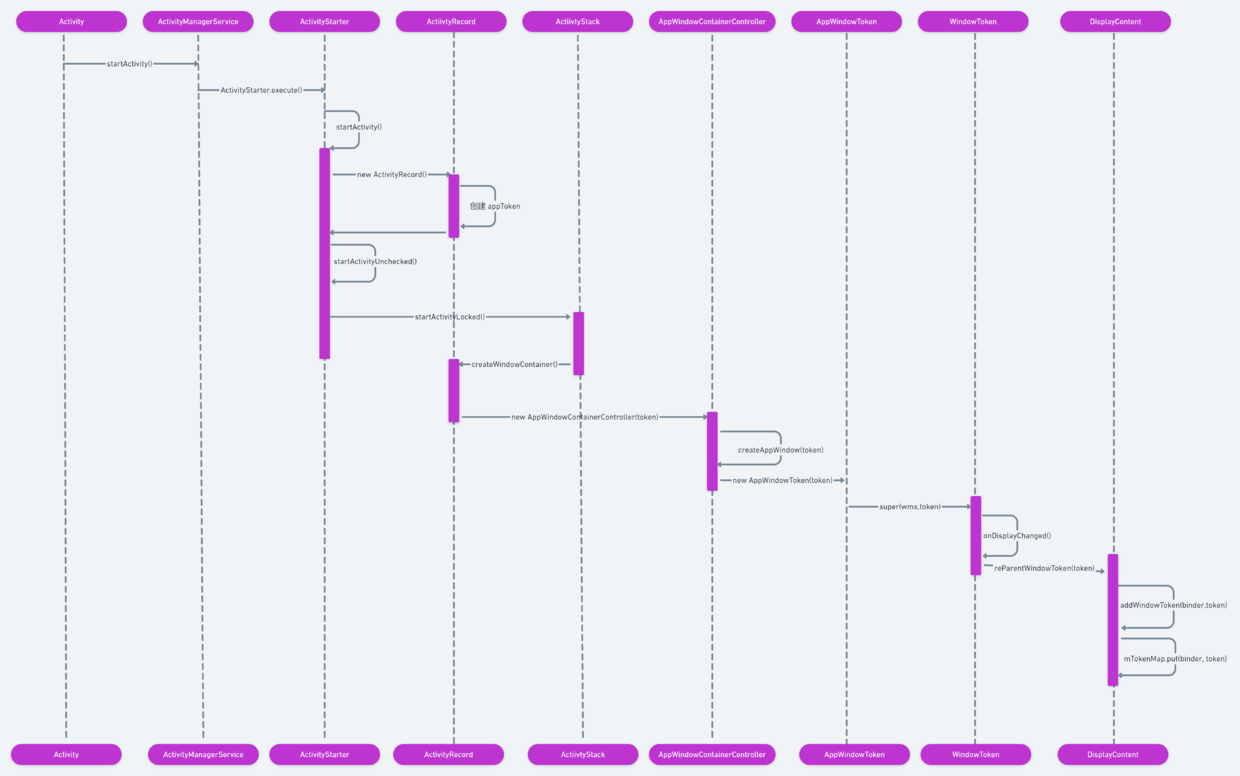Android 高工面试(难度:四星 (1),2021Android 高级面试题总结
@Overridepublic Object getSystemService(String name) {return SystemServiceRegistry.getSystemService(this, name);}
SystemServiceRegistry.getSystemService(this, name) 拿到的是已经提前初始化完成并缓存下来的系统服务,并没有携带任何的 Token。
registerService(Context.WINDOW_SERVICE, WindowManager.class,new CachedServiceFetcher<WindowManager>() {@Overridepublic WindowManager createService(ContextImpl ctx) {return new WindowManagerImpl(ctx);}});
所以,Android 不允许 Activity 以外的 Context 来创建和显示普通的 Dialog 。 这里的 普通 指的是文章开头示例代码中的普通 Dialog,并非 Toast,System Dialog 等等。Android 系统为了安全考虑,不想在 App 进入后台之后仍然可以弹出 Dialog,这样就会产生可以在其他 App 中弹窗的场景,造成一定的安全隐患。虽然通过 Dialog Theme 的 Activity 仍然可以实现这一需求,但是 Google 也在加强 对后台启动 Activity 的限制。
写到这里,问题似乎已经得到了解答。但是其实我们对于整个 Token 流程还是一片雾水的。试着想一下下面几个问题。
mToken 是在什么时机,什么地方创建的?
WMS 是如何拿到 mToken 的?
WMS 是如何校验 token 的?
......
真正掌握了这些问题之后,才能形成一个完整的知识闭环,但伴随而来的,是逃避不了的,枯燥乏味的 Read the fucking AOSP 。
谁创建了 Token?
先来看看 Token 到底是个什么样的类。
ActivityRecord.java
static class Token extends IApplicationToken.Stub {private final WeakReference<ActivityRecord> weakActivity;private final String name;
Token(ActivityRecord activity, Intent intent) {weakActivity = new We
akReference<>(activity);name = intent.getComponent().flattenToShortString();}
......}
Token 是 ActivityRecord 的静态内部类,它持有外部 ActivityRecord 的弱引用。继承自 IApplicationToken.Stub ,是一个 Binder 对象。它在 ActivityRecord 的构造函数中初始化。
ActivityRecord.java
ActivityRecord(ActivityManagerService _service, ProcessRecord _caller, int _launchedFromPid,int _launchedFromUid, String _launchedFromPackage, Intent _intent, String _resolvedType,ActivityInfo aInfo, Configuration _configuration,ActivityRecord _resultTo, String _resultWho, int _reqCode,boolean _componentSpecified, boolean _rootVoiceInteraction,ActivityStackSupervisor supervisor, ActivityOptions options,ActivityRecord sourceRecord) {service = _service;// 初始化 appTokenappToken = new Token(this, _intent);......}
一个 ActivtyRecord 代表一个 Activity 实例, 它包含了 Activity 的所有信息。在 Activity 的启动过程中,当执行到 ActivityStarter.startActivity() 时,会创建待启动的 ActivityRecord 对象,也间接创建了 Token 对象。
ActivityStarter.java
private int startActivity(IApplicationThread caller, Intent intent, Intent ephemeralIntent,String resolvedType, ActivityInfo aInfo, ResolveInfo rInfo,IVoiceInteractionSession voiceSession, IVoiceInteractor voiceInteractor,IBinder resultTo, String resultWho, int requestCode, int callingPid, int callingUid,String callingPackage, int realCallingPid, int realCallingUid, int startFlags,SafeActivityOptions options,boolean ignoreTargetSecurity, boolean componentSpecified, ActivityRecord[] outActivity,TaskRecord inTask, boolean allowPendingRemoteAnimationRegistryLookup,PendingIntentRecord originatingPendingIntent) {
......
// 构建 ActivityRecord,其中会初始化 tokenActivityRecord r = new ActivityRecord(mService, callerApp, callingPid, callingUid,callingPackage, intent, resolvedType, aInfo, mService.getGlobalConfiguration(),resultRecord, resultWho, requestCode, componentSpecified, voiceSession != null,mSupervisor, checkedOptions, sourceRecord);
......return startActivity(r, sourceRecord, voiceSession, voiceInteractor, startFlags,true /* doResume */, checkedOptions, inTask, outActivity);}
到这里, ActivityRecord.appToken 已经被赋值。所以 Token 是在 AMS 的 startActivity 流程中创建的。但是 Token 的校验显然是发生在 WMS 中的,所以 AMS 还得把 Token 交到 WMS 。
WMS 是如何拿到 Token 的?
继续跟下去,startActivity() 最后会调用到 ActivityStack.startActivityLocked(),这个方法就是把 Token 给到 WMS 的关键。
ActivityStack.java
void startActivityLocked(ActivityRecord r, ActivityRecord focusedTopActivity,boolean newTask, boolean keepCurTransition, ActivityOptions options) {
......
if (r.getWindowContainerController() == null) {// 创建 AppWindowContainerController 对象,其中包含 token 对象 r.createWindowContainer();
......
}
其他代码都省略了,重点关注 r.createWindowContainer(),这里的 r 就是一开始创建的 ActivityRecord 对象。
ActivityRecord.java
void createWindowContainer() {if (mWindowContainerController != null) {throw new IllegalArgumentException("Window container=" + mWindowContainerController
" already created for r=" + this);}
inHistory = true;
final TaskWindowContainerController taskController = task.getWindowContainerController();
......
// 构造函数中会调用 createAppWindow() 创建 AppWindowToken 对象 mWindowContainerController = new AppWindowContainerController(taskController, appToken,this, Integer.MAX_VALUE /* add on top */, info.screenOrientation, fullscreen,(info.flags & FLAG_SHOW_FOR_ALL_USERS) != 0, info.configChanges,task.voiceSession != null, mLaunchTaskBehind, isAlwaysFocusable(),appInfo.targetSdkVersion, mRotationAnimationHint,ActivityManagerService.getInputDispatchingTimeoutLocked(this) * 1000000L);
task.addActivityToTop(this);
......}
在 AppWindowContainerController 的构造函数中传入了之前已经初始化过的 appToken 。
AppWindowContainerController.java
public AppWindowContainerController(TaskWindowContainerController taskController,IApplicationToken token, AppWindowContainerListener listener, int index,int requestedOrientation, boolean fullscreen, boolean showForAllUsers, int configChanges,boolean voiceInteraction, boolean launchTaskBehind, boolean alwaysFocusable,int targetSdkVersion, int rotationAnimationHint, long inputDispatchingTimeoutNanos,WindowManagerService service) {super(listener, service);mHandler = new H(service.mH.getLooper());mToken = token;synchronized(mWindowMap) {......
atoken = createAppWindow(mService, token, voiceInteraction, task.getDisplayContent(),inputDispatchingTimeoutNanos, fullscreen, showForAllUsers, targetSdkVersion,requestedOrientation, rotationAnimationHint, configChanges, launchTaskBehind,alwaysFocusable, this);......}}
createAppWindow() 方法中会创建 AppWindowToken 对象,注意传入的 token 参数。
AppWindowContainerController.java
AppWindowToken createAppWindow(WindowManagerService service, IApplicationToken token,boolean voiceInteraction, DisplayContent dc, long inputDispatchingTimeoutNanos,boolean fullscreen, boolean showForAllUsers, int targetSdk, int orientation,int rotationAnimationHint, int configChanges, boolean launchTaskBehind,boolean alwaysFocusable, AppWindowContainerController controller) {return new AppWindowToken(service, token, voiceInteraction, dc,inputDispatchingTimeoutNanos, fullscreen, showForAllUsers, targetSdk, orientation,rotationAnimationHint, configChanges, launchTaskBehind, alwaysFocusable,controller);}
AppWindowToken.java
AppWindowToken(WindowManagerService service, IApplicationToken token, boolean voiceInteraction,DisplayContent dc, boolean fillsParent) {// 父类是 WindowTokensuper(service, token != null ? token.asBinder() : null, TYPE_APPLICATION, true, dc,false /* ownerCanManageAppTokens */);appToken = token;mVoiceInteraction = voiceInteraction;mFillsParent = fillsParent;mInputApplicationHandle = new InputApplicationHandle(this);}
这里调用了父类的构造函数,AppWindowToken 的父类是 WindowToken 。
WindowToken.java
WindowToken(WindowManagerService service, IBinder _token, int type, boolean persistOnEmpty,DisplayContent dc, boolean ownerCanManageAppTokens, boolean roundedCornerOverlay) {super(service);token = _token;windowType = type;mPersistOnEmpty = persistOnEmpty;mOwnerCanManageAppTokens = ownerCanManageAppTokens;mRoundedCornerOverlay = roundedCornerOverlay;// 接着跟进去 onDisplayChanged(dc);}
WindowToken.java
void onDisplayChanged(DisplayContent dc) {// 调用 DisplayContent.reParentWindowToken()dc.reParentWindowToken(this);mDisplayContent = dc;......}
DisplayContent.java
void reParentWindowToken(WindowToken token) {......addWindowToken(token.token, token);}
private void addWindowToken(IBinder binder, WindowToken token) {......// mTokenMap 是一个 HashMap<IBinder, WindowToken>,mTokenMap.put(binder, token);......}
mTokenMap 是一个 HashMap<IBinder, WindowToken> 对象,保存了 WindowToken 以及其 Token 信息。我们从 AMS 启动 Activity 一路追到这里,其实已经走到了 WMS 的逻辑。AMS 和 WMS 都是运行在 system_server 进程的,并不存在 binder 调用。AMS 就是按照上面的调用链把 Token 传递给了 WMS 。
再来一张清晰的流程图总结一下 Token 从 AMS 传递到 WMS 的整个流程:













评论